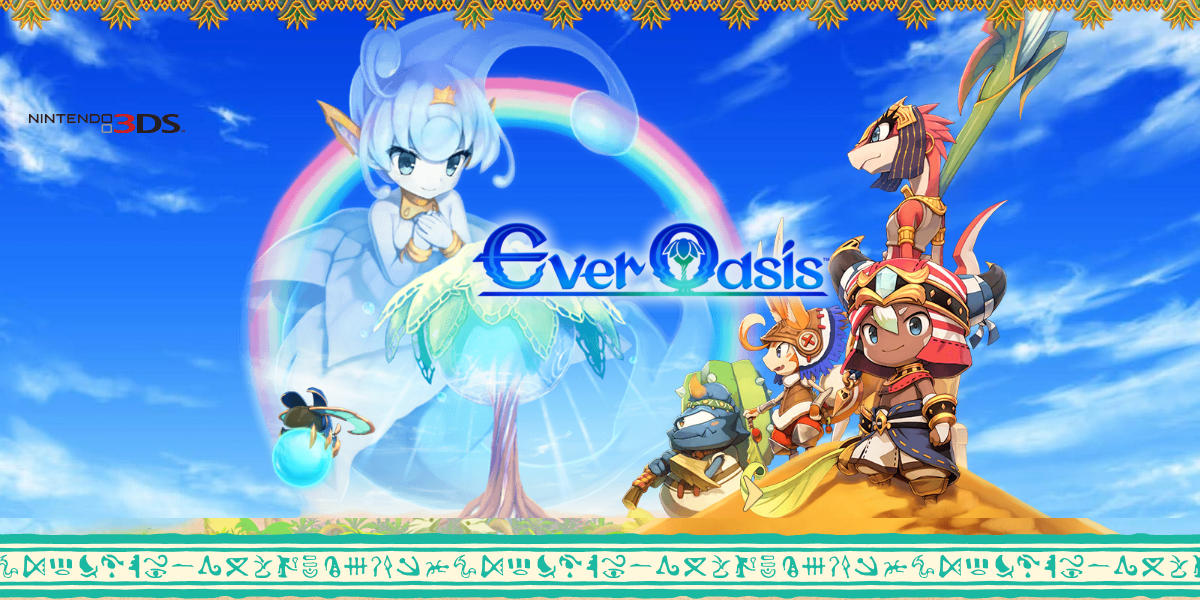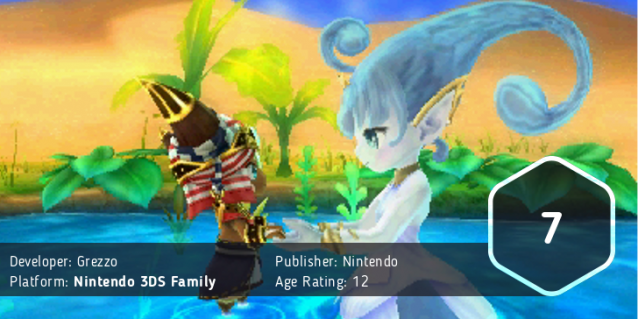Ever Oasis is a new game by Grezzo for the Nintendo 3DS, and introduces us to a new world with new characters. The little handheld seems to attract more new IP than its bigger cousins, but new IP always means new risks. So, does Ever Oasis sip the cool waters of the desert? Or does it stumble down a dune to fall into a mirage? Grab your camel and join me for this review, and we’ll find the answer together.
The story of Ever Oasis is that of a race of creatures known as Seedlings, who use their powers to create thriving villages around oases in the desert. Your lead character—you’re allowed to name them whatever you like, but by default the character is named Tethu if you choose male, or Tethi if you choose female. You start the game in the Oasis of your bigger brother, Nour, just as it is attacked by an evil known as Chaos. Chaos wrecks Nour’s Oasis, but he uses some of his power to turn you into a ball and send you across the desert to the last Oasis. The Oasis is run by a water spirit named Esna, and with her help, your goal is to grow the Oasis as much as you can, while keeping the forces of Chaos from destroying your new home.
 At its heart, Ever Oasis is a clever cross between town management sims such as Animal Crossing, and new generation RPGs such as Fantasy Life. Your oasis starts out small, with one or two villagers who own their own shops—called “Bloom Booths” in this game—but the numbers increase quite rapidly. The Bloom Booths produce currency (“Dewadems”) that you can use to buy upgrades for your seedling, or buy Bloom Booths provided you have the space in your Oasis. Once you venture outside of town, you’ll enter a free-roaming mode, allowing you to explore the desert beyond your Oasis. Here you’ll be able to complete missions for the various peoples you find roaming the deserts, attracting them to your Oasis. As your Oasis grows, you can start recruiting others to join you in your party. You’ll need them too, since everyone has an ability that helps you unlock areas of the desert.
At its heart, Ever Oasis is a clever cross between town management sims such as Animal Crossing, and new generation RPGs such as Fantasy Life. Your oasis starts out small, with one or two villagers who own their own shops—called “Bloom Booths” in this game—but the numbers increase quite rapidly. The Bloom Booths produce currency (“Dewadems”) that you can use to buy upgrades for your seedling, or buy Bloom Booths provided you have the space in your Oasis. Once you venture outside of town, you’ll enter a free-roaming mode, allowing you to explore the desert beyond your Oasis. Here you’ll be able to complete missions for the various peoples you find roaming the deserts, attracting them to your Oasis. As your Oasis grows, you can start recruiting others to join you in your party. You’ll need them too, since everyone has an ability that helps you unlock areas of the desert.
Which end of the game annoys you most depends largely upon how much you enjoy town sims, dungeon puzzles, or hacking and slashing creatures. The desert area is larger than I thought it would be, and there are numerous caves and ruins to explore. There’s an annoyance in only being limited to three party members, meaning frequent warp trips back to town to grab that one Seedling with the ability you need, heading back to where you were, unlocking this bit of dungeon there, and then walking into another room to discover you now need the ability of the one you had to swap out.
 Thankfully, Ever Oasis provides numerous checkpoints for you to save at (no autosave here!), as well as ways of warping between places you’ve discovered. Combat is fairly simple, with one button to perform a weak attack, one for a strong attack, and one to dodge. After that, it’s a matter of reading your opponent to know when to get out of the way. Those with New Nintendo 3DS systems will find full use of the c-stick and ZL and ZR buttons to make things easier, so the game is definitely a superior experience on the newer console. Naturally, it being an RPG, many of your sidequests will end up being fetchquests. It’s a hazard of the genre.
Thankfully, Ever Oasis provides numerous checkpoints for you to save at (no autosave here!), as well as ways of warping between places you’ve discovered. Combat is fairly simple, with one button to perform a weak attack, one for a strong attack, and one to dodge. After that, it’s a matter of reading your opponent to know when to get out of the way. Those with New Nintendo 3DS systems will find full use of the c-stick and ZL and ZR buttons to make things easier, so the game is definitely a superior experience on the newer console. Naturally, it being an RPG, many of your sidequests will end up being fetchquests. It’s a hazard of the genre.
 The town sim end of the game is a shallower experience, sadly. Much of your time at the Oasis will be spent running between shops and restocking goods, although a later game mechanic eventually automates that to some degree. The townsfolk generally do their own thing, as do your visitors. There is a small garden to manage, but later in the game even that can be outsourced to a Seedling who isn’t otherwise occupied. On the other hand, it’s heartening to see the Oasis grow and thrive under your caring hand, even if the story does take on a predictable series of twists and turns.
The town sim end of the game is a shallower experience, sadly. Much of your time at the Oasis will be spent running between shops and restocking goods, although a later game mechanic eventually automates that to some degree. The townsfolk generally do their own thing, as do your visitors. There is a small garden to manage, but later in the game even that can be outsourced to a Seedling who isn’t otherwise occupied. On the other hand, it’s heartening to see the Oasis grow and thrive under your caring hand, even if the story does take on a predictable series of twists and turns.
While the individual components of the game aren’t really original in any way, the way it’s put together makes for a charming, fun experience. The townsfolk might not be as fully-fledged as those of Animal Crossing, but you’ll still find that the balance of town-to-dungeon work is even enough that you can’t neglect one over the other. In total, there’s fun to be had in the 30-odd hours you’ll spend in this game and you won’t have to look far for it either, but getting to the end can become an exercise in repetitiveness.



